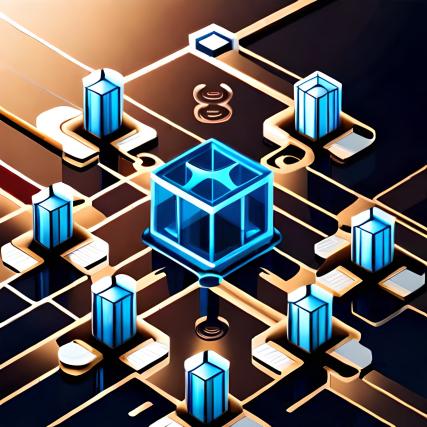Web3 is a phrase that represents the upcoming era of the internet where users can communicate with one another and with decentralized applications DApps without the need of intermediaries. Blockchain technology and cryptography are the driving force behind Web3 allowing for transactions and data sharing that are transparent and trustworthy. Web3 also enables novel forms of value creation and exchange such as tokens, cryptocurrency and smart contracts.
What is Web3?
Web3 refers to a new type of internet service constructed using decentralized blockchains, which are the shared ledger systems utilized by cryptocurrencies like Bitcoin and Ether. Web3 is not a singular technology or platform but a combination of protocols, applications and projects that share specific principles and objectives. Some of the key concepts of Web3 include –

- Web3 is user oriented because it places users at the core of the internet, granting them greater authority over their data, identity and digital assets. Users can interact with each other without intermediaries or gatekeepers.
- Web3 functions using incentives and economic mechanisms rather than relying on trusted third parties. Users can confirm the accuracy and integrity of data and transactions on the network without needing to rely on anyone else.
- Web3 allows anyone to join and contribute to the network without seeking permission or approval. Users can create and access any content or service they want without censorship or restrictions.
- Web3 facilitates the seamless communication and collaboration between different protocols, applications and projects. Users can transfer their data and assets across various platforms without encountering any difficulties or loss of value.
How does Web3 work?
Web3 operates by utilizing blockchain technology as the fundamental structure. Blockchain technology is a framework that enables multiple parties to reach consensus on a shared state of information without any need of central authority. Blockchain technology has three primary components –
- Network of nodes – These computers runs the software that maintains the blockchain. Node uses peer to peer protocols to validate transactions and arrive consensus on the state of the ledger.
- Ledger – This is a database that records all transactions occurring on the network. The ledger is divided into blocks linked together using cryptographic hashes. The ledger is immutable means that once a transaction is recorded then it cannot be changed or erased.
- Consensus mechanism – This is a set of rules determining how nodes agree on the validity and order of transactions on the ledger. The consensus mechanism guarantees that all nodes have the same version of the ledger and prevents malevolent actors from tampering with the data. Proof of work, proof of stake, proof of authority and proof of history are among the various consensus mechanisms.
Difference between Web2 and Web3 –
The internet has transformed how we communicate, share information and access services. Despite this, Web2 or the current web infrastructure faces certain challenges and limitations that prevent it from realizing its full potential. Web2 is centralized, implying that few intermediaries like big tech companies, governments and ISPs control the majority of data and power leading to issues like censorship, privacy breaches, data monopolies and security vulnerabilities.

Web3 is a new paradigm aiming to overcome these challenges and create a more open, just and democratic web. Web3 is decentralized means that no single entity has the power or authority to manipulate or censor network transactions and data. Powered by blockchain technology Web3 features a distributed ledger that transparently and immutably records and verifies every transaction. Web3 empowers users to own and govern their data and identity, as well as to participate in the network’s governance and value creation.
Why is Web3 important?
Web3 is significant because it presents a fresh approach to developing and utilizing internet services that aligns better with the original concept of the web a decentralized, open and collaborative space for everyone. Web3 also provides benefits that Web2 cannot provide or achieve such as –
- Ownership – Web3 offers users greater autonomy, options and ownership over their online experience. Users can choose which type of data to be share with other’s and how to monetize it. Governance mechanisms such as voting or staking allow users to participate in network decision making and value distribution.
- Innovation – Web3 promotes innovation by reducing barriers to entry and creates a level playing field for developers and entrepreneurs. Anyone can develop and introduce new applications and services without relying on centralized platforms or intermediaries. Users can access more extensive selection of applications and services tailored to their specific needs and preferences.
- Security – Web3 decreases the risks of hacking, fraud and corruption by removing single points of failure and central authorities. Decentralized networks that are resistant to tampering or manipulation enable users to store their data and assets. Cryptography and encryption allow users to safeguard their online privacy and identity.
Web3 Applications and Services –
Web3 services and applications utilize blockchain technology to store and process information and transactions in a decentralized and trust-less manner. Additionally, Web3 applications and services can incorporate other technologies that complement or improve upon blockchain technology such as –

- Smart contracts – These are programs that execute autonomously on the blockchain and enforce the rules and logic of a transaction or agreement. Smart agreements can automate complex procedures and interactions without intermediaries or human intervention.
- Decentralized storage – These are systems that enable users to store and access data on networks of distributed nodes instead of centralized servers. Distributed storage can enhance the scalability, accessibility and security of data storage.
- Decentralized identity – These are systems that allow users to establish and manage their digital identities on the blockchain without depending on third party providers or authorities. Distributed identity can enhance the privacy and autonomy of users online.
- Decentralized finance DeFi – These are financial services that run on the blockchain and grant users access to lending, borrowing, trading, investing and saving without intermediaries or regulations. Distributed finance can democratize and diversify the financial system.
What are some examples of Web3?
There are various Web3 applications and services that are presently operational or under development, serving multiple domains and use cases. Some of the most popular and promising ones comprise –
- Cryptocurrency – These are digital tokens that are issued and transmitted in blockchain without central bank or authority . Virtual currencies can be use as a currency of exchange or a store of value. There are several digital currencies that utilize blockchain technology as the backbone including Bitcoin, Ethereum, Polygon Matic.
- NFTs – These are non fungible tokens that portray unique digital assets on the blockchain such as art, music, games, collectibles and domain names. NFTs can be utilized to authenticate ownership, genuineness and scarcity of digital assets. Some of the most in-demand NFT platforms are OpenSea, Rarible, CryptoPunks and Decentraland.
- DAOs – These are decentralized autonomous organizations that are governed by smart contracts and operated by their members without a central authority or hierarchy. DAOs can be utilized to coordinate collective action, allocate resources and make decisions in a transparent and democratic way. Some of the most renowned DAOs are MakerDAO, Compound, Uniswap and MolochDAO.
- DApps – These are decentralized applications that operate on the blockchain and offer users various functionalities and services without intermediaries or censorship. DApps can be utilized for social networking, gaming, ecommerce, education, healthcare and more. Some of the most popular DApps are Brave, Audius, Steemit and Axie Infinity.



